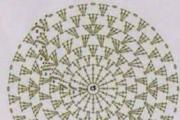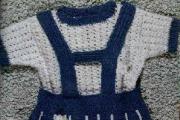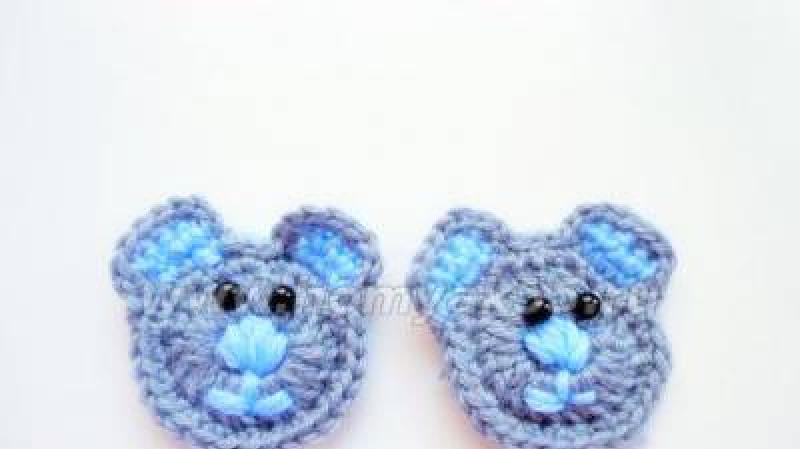How to sew a beret from an unwanted sweater. DIY warm clothes from an old sweater
In the closet of each of us there are, if not a couple of skeletons, then certainly a certain amount of clothes that you will never wear and would be a pity to throw away.
Oddly enough, the top spot in the ranking of unnecessary/unfashionable/moth-eaten items is occupied by sweaters. If you have found such a character on the mezzanine or in the depths of your wardrobe, but for sentimental reasons you cannot throw it in the trash can, give the item a second chance. Turn an old sweater into a cute, fashionable hat.
How to make a stylish beanie from an old sweater
The on-trend DIY beanie may become your go-to accessory this spring. Or a cute gift for girlfriends on March 8th. If you have enough sweaters and an hour of free time. By the way, the ability to hold a needle and thread in your hands is not required in this case. But what you need is:
1.An old sweater (preferably with an elastic band at the bottom);
2. Glue gun;
3. Measuring tape or tape measure;
4. Scarf for visual measurement (although a “centimeter” can be used for the same purpose);
5. Sharp scissors;
6.Marker or chalk. 
1. Tie the scarf around your head, secure it so that it is comfortable: not tight, but not too loose. 
2. Remove the scarf without untying it and apply it to the elastic band/edge of the sweater. The length of the scarf from edge to knot will be the width of your hat. 
3. Attach a measuring tape to the middle of the scarf and measure the height of the future hat. Rely on your taste or take measurements from your favorite hat of a similar design. The average height of beanie hats is in the range of 24-29 cm. 
4. Draw the shape of the future accessory. Don’t be afraid to stain the fabric with a marker - as a result, the measurements will not be visible at all. 
5. Now – cut. The main thing is to grab both layers of fabric at the same time. Therefore, the scissors must be really well sharpened. 
6. After the two halves are ready, take a glue gun and connect them, gluing along the very edge, as shown in the photo. Don't forget to leave the bottom unsealed, otherwise you won't be able to put on the hat. 
7.After the hat has already begun to resemble a hat, it’s time to take the scissors again and trim the top a little. This step is necessary so that the beanie fits better and does not resemble the “cockerel” familiar to many from the days of happy childhood. 
8. Fold the hat as in the photo below and glue the edges of the resulting “figure eight”. 

9. Now turn the hat inside out and put it on boldly. All seams, traces of glue and minor defects are reliably hidden from prying eyes. 

Even if the first hat pancake comes out lumpy, don’t be afraid to experiment and get better at it until you become a real master or destroy all the old clothes in the house. By the way, you can make leg warmers from the sleeves of a sweater, like the girl in the video. Waste-free crafts.
If you are planning to dismantle your wardrobe, this does not mean that your old sweater, which has already served its purpose, needs to be thrown away. If you love knitted things, you can decorate your home and yourself for the cold season, creating warmth and comfort around you. And all thanks to your sweater.
I bring to your attention 10 wonderful ideas that will make you feel like magicians in some way. Choose the “transformation” you like!
1. Cute hat
One or more old sweaters - for example those that children will no longer wear because they have outgrown them - can be made into warm hats for the winter.
You can also use additional fabrics to insulate or shape your new hat.

A warm sweater can make 2 options for a winter headdress.
Place a hat of the desired size on the sweater, trace the outline (taking into account the seams). Sew 2 parts of the hat using a sewing machine or by hand.
Or this hat is very easy to make and will take about 10 minutes.
The sewing algorithm is simple:
1. You will need: an old sweater, scissors and an old hat that you usually wear to measure your size.
2. Cut the bottom half of the sweater to the desired length.
3. Cut this part of the sweater along the seam.
4. Use an old hat to measure the size you need and cut off what you don't need.
5. Fold the resulting part into 3-4 layers.
6. Cut an arc at the top.
7. Sew the two edges of the hat.
8. Sew the top arcs.
9. Trim off the excess along the seam, flip it over and the hat is ready!
Here is a similar video instruction, only instead of using a glue gun, we will not glue, but sew the seams.
2. Warm mittens or mittens
All you need: a sweater, scissors, needles and thread (or a sewing machine).

Cut the mittens so that you can use the “elastic” (the bottom part of the sweater). Before cutting, take measurements from your hand or take a mitten from the person you are making new mittens for. Now all you have to do is sew the parts of the mitten from the inside out and turn them right side out. Ready!
Do you want to have mittens made with your own hands in a matter of minutes? 
Follow the next steps in the photo and read the instructions below to make sweater mittens: 
. Prepare the sweater: A wool sweater (at least 80% wool, but preferably 100%) works best for this idea. Wash the sweater with warm water, then dry it on a hot radiator to clump the wool fibers together so they don't fall apart when you cut. Your sweater will shrink significantly after drying. Tip: Wash your sweater in a mesh bag to avoid clogging the machine from wool fibers.
. Turn it inside out sweater inside out and place it on the table. Place your hand on one of the side edges of the sweater and trace the shape of the mitten around it. Add about an inch around the entire perimeter to create a seam. Don't forget to leave the bottom for cuffs.
. Cut out along your contour a mitten.
. Secure front and back layers with a few pins along the edges.
. Sew: Thread the needle through the floss and make simple stitches along your outline. Make sure the bottom of the mitten is wide enough for your hand to fit easily. Remove excess fabric. Be careful not to cut too close to the stitching as it may fall apart.
. Now comes the fun part! Turn the mitten inside out to see the finished handmade product.
. Decorate: Use buttons, colorful threads and other embellishments to add interest to the mitten.
. Repeat all steps on the opposite side of the sweater for another mitten.
It’s even easier to make warm mittens:
These mitts are very convenient for using a smartphone in winter.
- From the edge of the sweater, cut a rectangle 30 cm high and 20 cm long. Cut along the seam so you have two pieces.

- Fold both pieces lengthwise with the right sides facing inward. Mark a hole about 6 cm wide for the thumb using pins, 5 cm from the edge.
- Then stitch, leaving a hole for the thumb and making a hem at the bottom.
Or like this: 
- Cut the cuff from the sleeve.
- Determine your preferred glove finger length. Add about 2 cm to this length and cut off the sweater sleeve.
- Secure the sleeve cut on a sewing machine with a zigzag stitch or overlock stitch.
- Wrap the ends into the sleeve 2 cm and sew with a needle and thread.
- Put the glove on your hand and determine the desired location for the thumb hole. Cut where you want the hole to be. Carefully unravel the stitching threads until the hole is a comfortable size for your thumb. Then secure the hole with a thread and a needle so that the threads do not continue to unravel.
- Since the sleeves are a little looser than gloves should be, you'll need to reduce the diameter a bit. To do this, put gloves on your hands, pinch the excess fabric along the length of the sleeve, and secure with a few pins.
- Take off your gloves. Hand secure the trim and seam with needle and thread using a backstitch.
3. Elegant lampshade
You can use any sweater for a lampshade, but if you want an original and beautiful decor, then it is better to look for something cute among unnecessary things.
Next, you need to stretch the sweater over the lampshade and trim off the excess material at the top. At the same time, leave about 3-4 cm of material to fold and hot glue the edge along the top of the lampshade. Just a sight for sore eyes!

Or make something like this:
4. Gift wrapping
Your fall or winter gift can be soft and cozy! Cut strips of fabric from an old sweater and create a stylish package to suit your taste. You can use yarn for decoration (bubo, fringe). Or you can wrap the entire box and make a bow at the top. I wish you bright ideas!
5. New Year's wreath on the door
Warm greetings to everyone!
You can take a circle made of straw as the basis of the wreath. You will also need: a sweater (preferably red, green or shiny for the New Year), a glue gun and decor.
Cut the seam of the sweater sleeve to wrap the sleeve around the wreath piece. Glue the material at the joint and cut off the excess fabric. Take the remaining fabric and finish the next section of the wreath in the same way. Once the wreath is trimmed with fabric, add the desired decoration (letters, sparkles, pine cones, etc.).
6. Sweater for your beloved dog
For small dogs, you can use just a sweater sleeve, but make sure your dog fits in it before you get started.
You can make a sleeveless vest or sweater with three-quarter sleeves. Your dog will look stylish and will not freeze on a walk or in a cold house.
Simple overalls for dogs
Before you decide to sew clothes for your pet, you need to take accurate measurements. This is done according to the scheme. A dog jumpsuit does not require a lot of measurements. You only need to know the distance from the middle of the neck to the tail and the length of the limbs.

Well, if you decide to precisely adjust the clothes to the size of your pet, then you will need to take more measurements: neck circumference, chest volume (at the level behind the elbow bends), the length of the hind and front limbs, the distance from the neck to the tail, as well as from the bottom of the neck to the navel. All measurements must be done with your own hands using a special tape with millimeter divisions.

Explanation of values:
A - neck circumference;
B - distance from the middle of the neck to the tail;
C - distance between the hind and forelimbs;
D - length from collar to sleeve edge;
E - chest circumference behind the elbows;
F - girth of the hind limb at the widest part;
G - girth of the forelimb at the widest part;
H - muzzle circumference.
Elementary pattern: 
In order to make a pattern, you should determine the size from the neck to the tail of the dog, then divide it into eight parts. One part will become the cell of your diagram. Next, using the cells, you can draw the details of the product, which will subsequently need to be transferred to the fabric of the sweater.
7. Cozy flowerpots, mugs
This is an easy way to decorate plastic pots. For example, an idea for the finishing touches when decorating the house at the last minute for a holiday party.

Sweater sleeves are suitable for decorating flowerpots. Measure the height of your pot and cut off part of the sleeve, leaving about 4cm of extra space. Place the fabric over the flower pot and, if necessary, trim the edges (sew, glue, etc.)

A simple but interesting touch to your interior: 
Using the same principle, you can dress vases, mugs, etc. in winter clothes. 
8. Pet bed
If you made a pillow for yourself, take care of your four-legged friend too. Sewing a bed from an old sweater is probably even easier than sewing an ordinary pillow.
To do this, simply insert a pillow into the sweater itself (preferably a thick one so that it does not press under the weight of the animal), tightly stuff the sleeves with any fabric material, fasten them together so that they frame the resulting base and act as a side. That's it, the bed is ready.

If you are not good at needlework, it will most likely not turn out very smooth, but believe me, your pet will still be grateful to you, especially since this bed will smell like you, and pets really appreciate things with the owner’s scent.
Want to make it more accurate? 
1. Sew the neck of the sweater, turning it inside out, and sew the sweater at the height of the necklines
for the sleeves to create a single side.
2. Fill the side with holofiber, synthetic padding or other material.
3. Sew the sleeve cuffs together.
4. Place a round pillow inside the rest of the sweater and connect everything to the sleeves.

A comfortable bed in front of you!
9. Thought pillows
One way to decide the fate of an old sweater is to sew decorative pillows from it for a sofa.
First, let's look at an old sweater. Does it match the color of the room design, does it combine with existing accessories? The sweater should not be too worn, otherwise it will not turn out to be a beautiful, neat new thing. As a last resort, we use only well-preserved parts of it.
Place the pillow on the sweater and mark the size you need.
We cut off the top part of the sweater with the neck and sleeves and cut out a pillow cover of the size we need.
Sew the sides and top.
You can make a button closure on the bottom part or simply sew it up after the pillow is placed in the cover.
It will require a minimum of cutting and sewing work, but such pillows will delight the eye for a long time and create a warm and welcoming atmosphere in the home.
You can decorate them as you wish with buttons, flowers, or other decorations.
10. Plaid
To make your own blanket, collect all the woolen sweaters in the house. I think every housewife has things that have not been worn for a long time, but still look quite decent and can serve as excellent material for a future blanket. Think about what color scheme you would like your blanket to be in. For my blanket I used about 10 sweaters in blue, gray and cream. But you can use more. Some of my sweaters I bought on sale, and they only cost me $1, or you can visit second-hand stores that sell fairly high-quality items at a reasonable price. Ask your friends, they might be happy to give you their unwanted woolen items!

Pre-prepare your sweaters: open seams, remove buttons, snaps, zippers. Sort fabrics by color and wash them separately by color to prevent them from fading.
Place sweaters in an old pillowcase to prevent lint from clogging up your washing machine. Then wash them with detergent in hot and then cold water, finishing with a spinner.
This is necessary in order to see which of the sweaters shrink more during the washing process, and which do not change their original shape at all.

To do this, you need to prepare a template of the desired size from cardboard. 
After making the squares, figure out how they will be arranged by laying them out on the floor. 
You can start sewing. I used the largest straight stitch on my sewing machine. Leave an allowance of about 1/4 inch. Sew all the pieces together, gently pushing the fabric, if necessary, slowly drag it through the sewing machine. After sewing, the sewing machine will have to be thoroughly cleaned, as a lot of lint remains.

Here are the large pieces I finished with before making the final seams. 
From the inside it looks like this:  /span>
/span>
T I also made a wool lining for my blanket; you can use flannel, which would also make a great lining. I also rounded the corners of the blanket using the template.

As for the finishing, I do it by hand using a closed overlock stitch. I really like the look this stitch gives to the blanket. This is exactly how I imagine a warm and cozy blanket at home. I hope the photos help give you a better idea of how to make the stitch.


Imagine how useful it would be to have such a blanket handy on the sofa on cool winter evenings. 
Based on materials from theyou.ru, designadecor.blogspot.ru,
Now your favorite sweater can stay with you for several more years!
New life for old things.
A familiar situation - the closet is packed to capacity, there’s nowhere to even stuff socks, but all you can wear out of it is a pair of jeans, an oversized cozy sweatshirt, two simple sweaters and a T-shirt bought a hundred years ago?
Because, no matter how beautiful and elegant a thing is, we will always be drawn to coziness and comfort.
And that is why some new clothes, after their only release, lie untouched for years, and some are worn out to holes. Then they become “household”, patched, trimmed and worn a little more... And then more or less “living” flaps are cut out of them and used as potholders, kitchen towels, etc.... Conclusion - with your favorite thing as with It is very, very difficult to separate from a loved one! So I suggest reviewing your wardrobe for “no five-minute throwaway items” and giving them a second chance! After all, how many useful, beautiful and original things can be made from the same sweater!
1. Bag
Unusual knitted bags can be easily made, even if you don't like to knit! You can use a ready-made knit of an unnecessary sweater - just cut out two pieces of the desired size and shape, sew them together, attach the handles, make an inner cover with pockets for your favorite little things, and the new thing is ready!
A soft and cozy winter bag is very easy to make. 
We cut out the sleeves slightly larger than the armhole and the neckline - as shown in the picture 
Place the material so that the side seams of the sweater meet at the front. Pin the bottoms of the sweater together and sew in a straight line to join the two sides. We make a hem along the top and on the handles. Turn the bag inside out. Ready!

Unusual knitted bags can be easily made, even if you don't like to knit! You can use a ready-made knit of an unnecessary sweater - just cut out two pieces of the desired size and shape, sew them together, attach the handles, make an inner cover with pockets for your favorite little things, insert a zipper or button if necessary, and the new thing is ready!
To prevent the bag from looking like a shopping bag, decorate the bag. 





2. Warm leggings
These bright and warm socks are sewn in one sitting from the sleeves of an old sweater. You just need to cut a piece of the sleeve to the desired length and carefully hem it at the cut site so that the edge does not fray.

The most affordable way to use an old sweater. Cut off the sleeves and you're done. Can be worn under or over clothes and shoes.
These socks look very stylish under high boots or on top of ankle boots.
3. Warm socks
As you already understand, you don’t have to know how to knit to have warm wool socks at home. You can, of course, buy them...
But a real needlewoman is used to correcting life’s imperfections on her own, using improvised means. Warm socks can be easily made from the sleeves of an old sweater.
And an old sweater that no one wears anymore, as a rule, is in every home.

Let's add scissors, safety pins, yarn and a large gypsy needle to it. 
Take your measurements. 
Resolutely, without sparing the sweater, we cut out the insoles of future slippers according to the template. The main thing is not to touch the sleeves yet.
Because we will need them for the upper part of the slippers.

Cut to the required length.
Now we fasten the sole and the “boot” with safety pins so that our parts do not move when sewing.

Now we need a large needle. Using it, we sew the “sole” to the upper part using an overcast stitch. For beauty, we add a similar seam along the upper edge of the slippers.
Ugg slippers:
Using the patterned sleeves of an old sweater will help you make another cute winter socks for cold days.


How to make socks from an old sweater
4. Scarf-snood
You can easily and quickly sew a snood with your own hands from an old sweater. For this we need:
- 2 unnecessary sweaters (you can take scarves)
- scissors
- sewing machine

Everything is done extremely simply:
- Cut off the bottom of each sweater. Choose the width you want to get the snood.

- Cut one side of each piece to create long strips.
- Now sew all the sides together, leaving a small opening.

- Turn the snood out through the remaining gap and sew it to the end.
Another option on how to make an original designer scarf with your own hands.

You will need:
- An old sweater made from acrylic yarn (try to avoid 100% cotton materials, because they are poorly suited for these purposes due to their properties)
- Scissors
- Sewing machine or thread with a simple sewing needle
- Measuring tape
Step 1: Start by cutting the sweater just below the sleeve line on all sides.
Advice: The original size of the sweater will determine the dimensions of the finished scarf. The larger the sweater, the larger the scarf you can make.

Step 2. Decorative edge processing
Use a sewing machine or hem the edges of the product by hand with beautiful decorative stitches.

Step 3. Cut out pieces from the sweater and form blanks for the future scarf 
Step 4. Finish altering the clothes with your own hands.
The scarf is almost ready. Now sew all the sweater pieces together. You can leave small shreds at the ends by cutting the edges into strips with scissors. This way you can create the effect of a real scarf.
5. Dickey
The obvious thing that can be made from a sweater is a bib by simply cutting off the neckline. If you know how to knit, you can tie the shirtfront around the edge. By making a hat from the same sweater and decorating it with beads, you will get a stylish set.



6. Socks-slippers
If you washed a sweater and it came down to child size, then don’t be upset. Armed with scissors and a needle, you can make beautiful new slippers that will keep you warm in winter.

As popular wisdom says: your feet need to be kept warm. These stylish slippers are the perfect solution for those who hate cold floors.
What we need:
- sweater
- pattern paper
- scissors
- sewing threads
- needle
- hook
- knitting threads
Make patterns for the leg.
Patterns should consist of 2 parts for each leg - one solid, the second with a hole in the middle.

Cut taking into account the seams.
Sew together, turn inside out and crochet the edge. 
7. Soft slippers
Excellent warm soft slippers made from an old sweater will warm your feet
You will need
- unnecessary sweater
- felt (20 cm x 30 cm) or ready-made insoles
- A4 cardboard sheet
- pencil
- scissors
- double sided adhesive tape
- needles and threads
- tailor's chalk
- sewing machine
Work progress:
It is cheaper and easier to buy ready-made insoles. But, if anything, they can easily be made from felt. To begin, trace the contours of your leg on cardboard.
Then cut out a template from cardboard.
Lay out the template on felt or other dense material (leather, thick batting, etc.), trace and cut out.
You will need 4 identical insoles.
Apply double-sided tape to the first insole and apply it to the right side of the fabric.
Do the same with the other insole and place it on the wrong side of the fabric. It is necessary that the edges of the felt insoles match as much as possible.
Now you need to sew the insoles and fabric. This can be done manually, although a sewing machine will still save your nerves and time!
Let's work on the upper part of the slippers! Measure approximately 13 cm, starting from the sleeve cuff, and cut.
Sew up the cuffs and round the opposite side of the piece as shown in the picture.
Now you have a piece of knitted fabric with insoles sewn on both sides and a cap. And there should be two such blanks!
So finish it and get to the fun part - stitching the fragments together!
Place the cap, which is also the future top of the slipper, on the front side over the sewn insole. Its top should coincide with the center of the rounded side. Sew the pieces together at this point.
Sew both pieces in the round, moving from left to right and evenly taking the excess fabric around the insoles into the stitch. Thanks to the stitches already made, this will be easy to do.
Turn the resulting structure inside out so that all the seams remain inside the sneaker, and make two cuts on both sides of the heel. It is necessary that the cuts end a few millimeters from the insole.
To make the heels of the slippers, you need to form them from these three pieces of fabric.
Then sew the part - you should get two vertical seams. Then sew the part - you should get two vertical seams.
Finally, the slipper cuffs! Trim the bottom edge of the sweater. Fold the raw edge so that the width of the strip is approximately 5 cm. Cut it into 2 parts. Attach the tape as shown in the photo.
Wrap the resulting knitted ribbon around the slipper, glue and secure with stitches. Do the same with the second tape. Made!
These are such cute house slippers!
Three new things from one old sweater
If you have an old sweater lying around in your closet that has long gone out of fashion or is simply boring to you, then do not rush to throw it away. Resourceful craftswoman Olga Volkova claims that you can make three stylish new things from one old sweater.
Firstly, you can make an original and stylish knitted bag. Such unusual bags have become very fashionable this season.

Secondly, from the neck of a sweater you can make a very fashionable and original decor for a cup, which will give the interior more coziness, warmth and comfort. Moreover, in this case it is better to use a sweater with an ornament. If the sweater is plain, then you can decorate the cup with embroidery, beads, buttons, and bows - whatever your imagination inspires.
When you make this decoration, do not forget to step back about 1.5 cm from the edge of the cup to make it comfortable to drink.
Thirdly, you can use the sleeves of an old sweater to make stylish, but fun and warm knitted home boots. In this case, the sleeve cuffs will be at the top, and where the sleeve was sewn to the base of the sweater, there will be a sole. You can use ready-made insoles as soles or cut them out of felt and felt.
Don't look at the fact that your favorite sweater is already old. He's still wow!
The opportunity to give it a second life is in your hands. I really hope that at least one thing from this top was useful to you!
Based on materials from treasurebox.ru, lady-antikrizis.ru, www.liveinternet.ru, koketkat.com
Nobody wears them anymore, and it’s a shame to throw them away. Is this a familiar situation?
If you are planning to dismantle your wardrobe, this does not mean that your old sweater, which has already served its purpose, needs to be thrown away. If you love knitted things, you can decorate your home and yourself for the cold season, creating warmth and comfort around you. And all thanks to your sweater.
I bring to your attention 10 wonderful ideas that will make you feel like magicians in some way. Choose the “transformation” you like!
1. Cute hat
One or more old sweaters - for example those that children will no longer wear because they have outgrown them - can be made into warm hats for the winter.
You can also use additional fabrics to insulate or shape your new hat.

A warm sweater can make 2 options for a winter headdress.

Place a hat of the desired size on the sweater, trace the outline (taking into account the seams). Sew 2 parts of the hat using a sewing machine or by hand.

Or this hat is very easy to make and will take about 10 minutes. 
The sewing algorithm is simple:
1. You will need: an old sweater, scissors and an old hat that you usually wear to measure your size.
2. Cut the bottom half of the sweater to the desired length.
3. Cut this part of the sweater along the seam.
4. Use an old hat to measure the size you need and cut off what you don't need.
5. Fold the resulting part into 3-4 layers.


6. Cut an arc at the top.
7. Sew the two edges of the hat.
8. Sew the top arcs.
9. Trim off the excess along the seam, flip it over and the hat is ready!

Here is a similar video instruction, only instead of using a glue gun, we will not glue, but sew the seams.
2. Warm mittens or mittens
All you need: a sweater, scissors, needles and thread (or a sewing machine).

Cut the mittens so that you can use the “elastic” (the bottom part of the sweater). Before cutting, take measurements from your hand or take a mitten from the person you are making new mittens for. Now all you have to do is sew the parts of the mitten from the inside out and turn them right side out. Ready!

Do you want to have mittens made with your own hands in a matter of minutes? 
Follow the next steps in the photo and read the instructions below to make sweater mittens: 
. Prepare the sweater: A wool sweater (at least 80% wool, but preferably 100%) works best for this idea. Wash the sweater with warm water, then dry it on a hot radiator to clump the wool fibers together so they don't fall apart when you cut. Your sweater will shrink significantly after drying. Tip: Wash your sweater in a mesh bag to avoid clogging the machine from wool fibers.
. Turn it inside out sweater inside out and place it on the table. Place your hand on one of the side edges of the sweater and trace the shape of the mitten around it. Add about an inch around the entire perimeter to create a seam. Don't forget to leave the bottom for cuffs.
. Cut out along your contour a mitten.
. Secure front and back layers with a few pins along the edges.
. Sew: Thread the needle through the floss and make simple stitches along your outline. Make sure the bottom of the mitten is wide enough for your hand to fit easily. Remove excess fabric. Be careful not to cut too close to the stitching as it may fall apart.
. Now comes the fun part! Turn the mitten inside out to see the finished handmade product.
. Decorate: Use buttons, colorful threads and other embellishments to add interest to the mitten.
. Repeat all steps on the opposite side of the sweater for another mitten.
It’s even easier to make warm mittens: 
These mitts are very convenient for using a smartphone in winter.
- From the edge of the sweater, cut a rectangle 30 cm high and 20 cm long. Cut along the seam so you have two pieces.

- Fold both pieces lengthwise with the right sides facing inward. Mark a hole about 6 cm wide for the thumb using pins, 5 cm from the edge.
- Then stitch, leaving a hole for the thumb and making a hem at the bottom.
Or like this: 
- Cut the cuff from the sleeve.
- Determine your preferred glove finger length. Add about 2 cm to this length and cut off the sweater sleeve.
- Secure the sleeve cut on a sewing machine with a zigzag stitch or overlock stitch.
- Wrap the ends into the sleeve 2 cm and sew with a needle and thread.
- Put the glove on your hand and determine the desired location for the thumb hole. Cut where you want the hole to be. Carefully unravel the stitching threads until the hole is a comfortable size for your thumb. Then secure the hole with a thread and a needle so that the threads do not continue to unravel.
- Since the sleeves are a little looser than gloves should be, you'll need to reduce the diameter a bit. To do this, put gloves on your hands, pinch the excess fabric along the length of the sleeve, and secure with a few pins.
- Take off your gloves. Hand secure the trim and seam with needle and thread using a backstitch.

3. Elegant lampshade
You can use any sweater for a lampshade, but if you want an original and beautiful decor, then it is better to look for something cute among unnecessary things.

Next, you need to stretch the sweater over the lampshade and trim off the excess material at the top. At the same time, leave about 3-4 cm of material to fold and hot glue the edge along the top of the lampshade. Just a sight for sore eyes!

Or make something like this:

4. Gift wrapping
Your fall or winter gift can be soft and cozy! Cut strips of fabric from an old sweater and create a stylish package to suit your taste. You can use yarn for decoration (bubo, fringe). Or you can wrap the entire box and make a bow at the top. I wish you bright ideas!

5. New Year's wreath on the door
Warm greetings to everyone!
You can take a circle made of straw as the basis of the wreath. You will also need: a sweater (preferably red, green or shiny for the New Year), a glue gun and decor.
Cut the seam of the sweater sleeve to wrap the sleeve around the wreath piece. Glue the material at the joint and cut off the excess fabric. Take the remaining fabric and finish the next section of the wreath in the same way. Once the wreath is trimmed with fabric, add the desired decoration (letters, sparkles, pine cones, etc.).

6. Sweater for your beloved dog
For small dogs, you can use just a sweater sleeve, but make sure your dog fits in it before you get started.

You can make a sleeveless vest or sweater with three-quarter sleeves. Your dog will look stylish and will not freeze on a walk or in a cold house.

Simple overalls for dogs
Before you decide to sew clothes for your pet, you need to take accurate measurements. This is done according to the scheme. A dog jumpsuit does not require a lot of measurements. You only need to know the distance from the middle of the neck to the tail and the length of the limbs.

Well, if you decide to precisely adjust the clothes to the size of your pet, then you will need to take more measurements: neck circumference, chest volume (at the level behind the elbow bends), the length of the hind and front limbs, the distance from the neck to the tail, as well as from the bottom of the neck to the navel. All measurements must be done with your own hands using a special tape with millimeter divisions.

Explanation of values:
A - neck circumference;
B - distance from the middle of the neck to the tail;
C - distance between the hind and forelimbs;
D - length from collar to sleeve edge;
E - chest circumference behind the elbows;
F - girth of the hind limb at the widest part;
G - girth of the forelimb at the widest part;
H - muzzle circumference.
Elementary pattern: 
In order to make a pattern, you should determine the size from the neck to the tail of the dog, then divide it into eight parts. One part will become the cell of your diagram. Next, using the cells, you can draw the details of the product, which will subsequently need to be transferred to the fabric of the sweater.
7. Cozy flowerpots, mugs
This is an easy way to decorate plastic pots. For example, an idea for the finishing touches when decorating the house at the last minute for a holiday party.

Sweater sleeves are suitable for decorating flowerpots. Measure the height of your pot and cut off part of the sleeve, leaving about 4cm of extra space. Place the fabric over the flower pot and, if necessary, trim the edges (sew, glue, etc.)

A simple but interesting touch to your interior: 
Using the same principle, you can dress vases, mugs, etc. in winter clothes. 

8. Pet bed
If you made a pillow for yourself, take care of your four-legged friend too. Sewing a bed from an old sweater is probably even easier than sewing an ordinary pillow.
To do this, simply insert a pillow into the sweater itself (preferably a thick one so that it does not press under the weight of the animal), tightly stuff the sleeves with any fabric material, fasten them together so that they frame the resulting base and act as a side. That's it, the bed is ready.

If you are not good at needlework, it will most likely not turn out very smooth, but believe me, your pet will still be grateful to you, especially since this bed will smell like you, and pets really appreciate things with the owner’s scent.

Want to make it more accurate? 
1. Sew the neck of the sweater, turning it inside out, and sew the sweater at the height of the necklines
for the sleeves to create a single side.
2. Fill the side with holofiber, synthetic padding or other material.
3. Sew the sleeve cuffs together.
4. Place a round pillow inside the rest of the sweater and connect everything to the sleeves.

A comfortable bed in front of you!

9. Thought pillows
One way to decide the fate of an old sweater is to sew decorative pillows from it for a sofa. Thus, those who do not know how to knit at all will have the opportunity to decorate their home with unusual knitted items.
To make the pillows look more original, choose plain sweaters with complex knitted patterns, braids, “bumps,” or sweaters with Scandinavian patterns on a white background.

First, let's look at an old sweater. Does it match the color of the room design, does it combine with existing accessories? The sweater should not be too worn, otherwise it will not turn out to be a beautiful, neat new thing. As a last resort, we use only well-preserved parts of it.

Place the pillow on the sweater and mark the size you need. 
We cut off the top part of the sweater with the neck and sleeves and cut out a pillow cover of the size we need.
Sew the sides and top.


You can make a button closure on the bottom part or simply sew it up after the pillow is placed in the cover.

It will require a minimum of cutting and sewing work, but such pillows will delight the eye for a long time and create a warm and welcoming atmosphere in the home.
You can decorate them as you wish with buttons, flowers, or other decorations.

10. Plaid
To make your own blanket, collect all the woolen sweaters in the house. I think every housewife has things that have not been worn for a long time, but still look quite decent and can serve as excellent material for a future blanket. Think about what color scheme you would like your blanket to be in. For my blanket I used about 10 sweaters in blue, gray and cream. But you can use more. Some of my sweaters I bought on sale, and they only cost me $1, or you can visit second-hand stores that sell fairly high-quality items at a reasonable price. Ask your friends, they might be happy to give you their unwanted woolen items!

Pre-prepare your sweaters: open seams, remove buttons, snaps, zippers. Sort fabrics by color and wash them separately by color to prevent them from fading.
Place sweaters in an old pillowcase to prevent lint from clogging up your washing machine. Then wash them with detergent in hot and then cold water, finishing with a spinner.
This is necessary in order to see which of the sweaters shrink more during the washing process, and which do not change their original shape at all.

To do this, you need to prepare a template of the desired size from cardboard. 
After making the squares, figure out how they will be arranged by laying them out on the floor. 
You can start sewing. I used the largest straight stitch on my sewing machine. Leave an allowance of about 1/4 inch. Sew all the pieces together, gently pushing the fabric, if necessary, slowly drag it through the sewing machine. After sewing, the sewing machine will have to be thoroughly cleaned, as a lot of lint remains.

Here are the large pieces I finished with before making the final seams. 
From the inside it looks like this: 
I also made a wool lining for my blanket, you can use flannel which would also make a great lining. I also rounded the corners of the blanket using the template.

As for the finishing, I do it by hand using a closed overlock stitch. I really like the look this stitch gives to the blanket. This is exactly how I imagine a warm and cozy blanket at home. I hope the photos help give you a better idea of how to make the stitch.


Imagine how useful it would be to have such a blanket handy on the sofa on cool winter evenings. 
Based on materials from theyou.ru, designadecor.blogspot.ru
Now your favorite sweater can stay with you for several more years!
New life for old things.

In the closet of each of us there are, if not a couple of skeletons, then certainly a certain amount of clothes that you will never wear and would be a pity to throw away. Oddly enough, the top spot in the ranking of unnecessary/unfashionable/moth-eaten items is occupied by sweaters. If you have found such a character on the mezzanine or in the depths of your wardrobe, but for sentimental reasons you cannot throw it in the trash can, give the item a second chance. Turn an old sweater into a cute, fashionable hat.

The on-trend DIY beanie may be your favorite fall accessory. Or a cute gift for girlfriends. If you have enough sweaters and an hour of free time. By the way, the ability to hold a needle and thread in your hands is not required in this case. But what you need is:
1. An old sweater (preferably with an elastic band at the bottom);
2. Glue gun;
3. Measuring tape or tape measure;
4. Scarf for visual measurement (although a “centimeter” can be used for the same purpose);
5. Sharp scissors;
6. Marker or chalk.

1. Tie the scarf around your head, secure it so that it is comfortable: not tight, but not too loose.

2. Remove the scarf without untying it and apply it to the elastic band/edge of the sweater. The length of the scarf from edge to knot will be the width of your hat.

3. Attach the measuring tape to the middle of the scarf and measure the height of the future hat. Rely on your taste or take measurements from your favorite hat of a similar design. The average height of beanie hats is in the range of 24-29 cm.

4. Draw the shape of the future accessory. Don’t be afraid to stain the fabric with a marker - as a result, the measurements will not be visible at all.

5. Now, cut it. The main thing is to grab both layers of fabric at the same time. Therefore, the scissors must be really well sharpened.

6. After the two halves are ready, take a glue gun and connect them, gluing along the very edge, as shown in the photo. Don't forget to leave the bottom unsealed, otherwise you won't be able to put on the hat.

7. After the hat has already begun to resemble a hat, it’s time to take the scissors again and trim the top a little. This step is necessary so that the beanie fits better and does not resemble the “cockerel” familiar to many from the days of happy childhood.

8. Fold the hat as in the photo below and glue the edges of the resulting “figure eight”.














